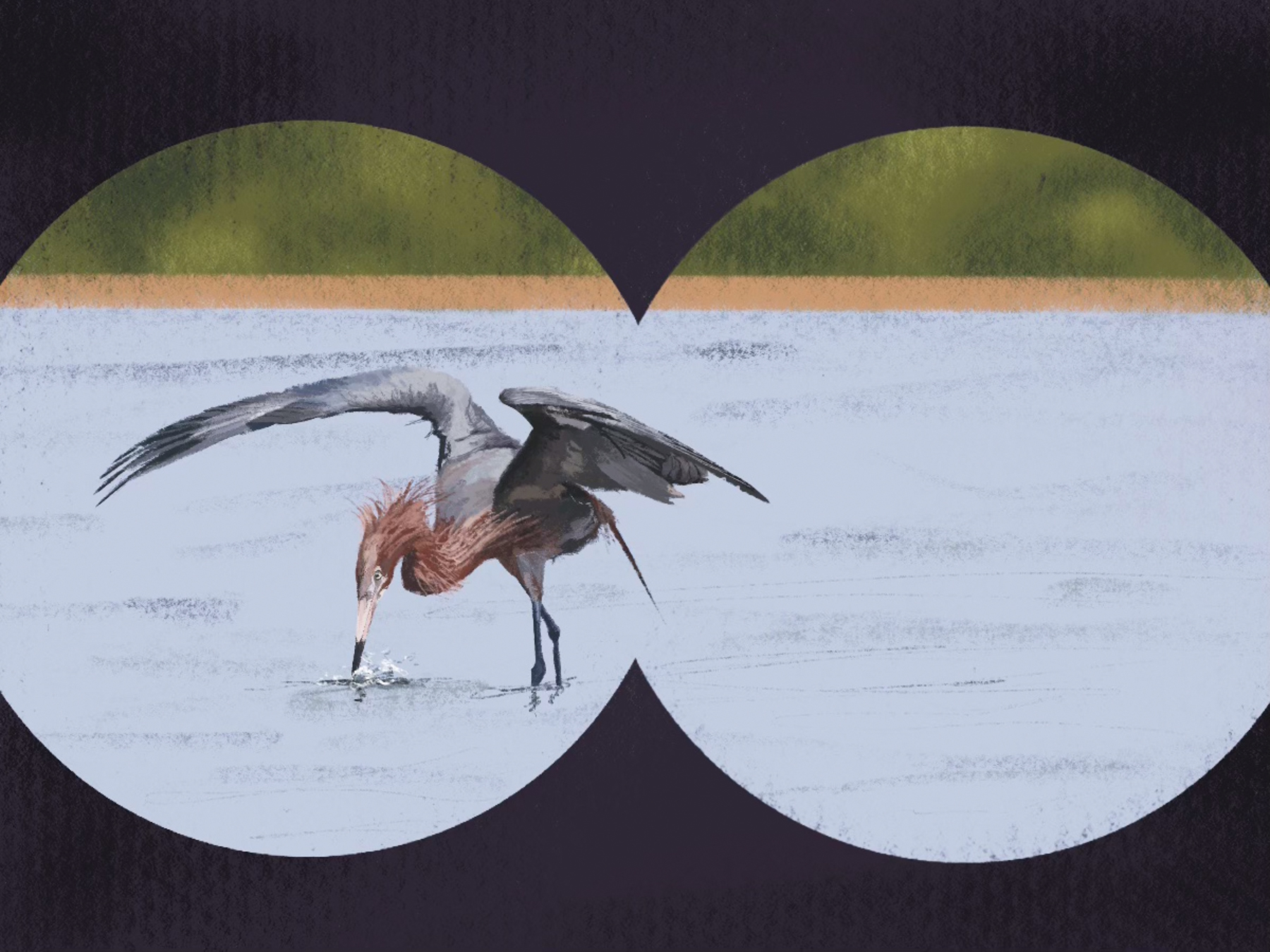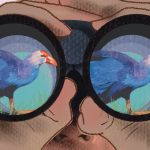Illustration by Jillian Duke.
STORY & PHOTOS BY MAX WEAKLEY
Scrub Ridge Trail
Pulling up to the Scrub Ridge Trail at 10:50 a.m., my only goal was to finally find the Florida scrub-jay. I had played recordings of their rough, scratchy calls the night before and brought them back into mind as I parked. Then I grabbed my camera and headed to the south loop trail to search for the jays.
After just shy of half a mile, I heard a call I recognized. Slowly working my way through the mangrove knee roots, trying to keep silent and not slip in the slick muck, I found my way into an opening where I could clearly see the calling bird. Clinging to the top of a scraggly bush on the other side of a shallow, brackish lagoon, an eastern meadowlark (Sturnella magna) sang his heart out.
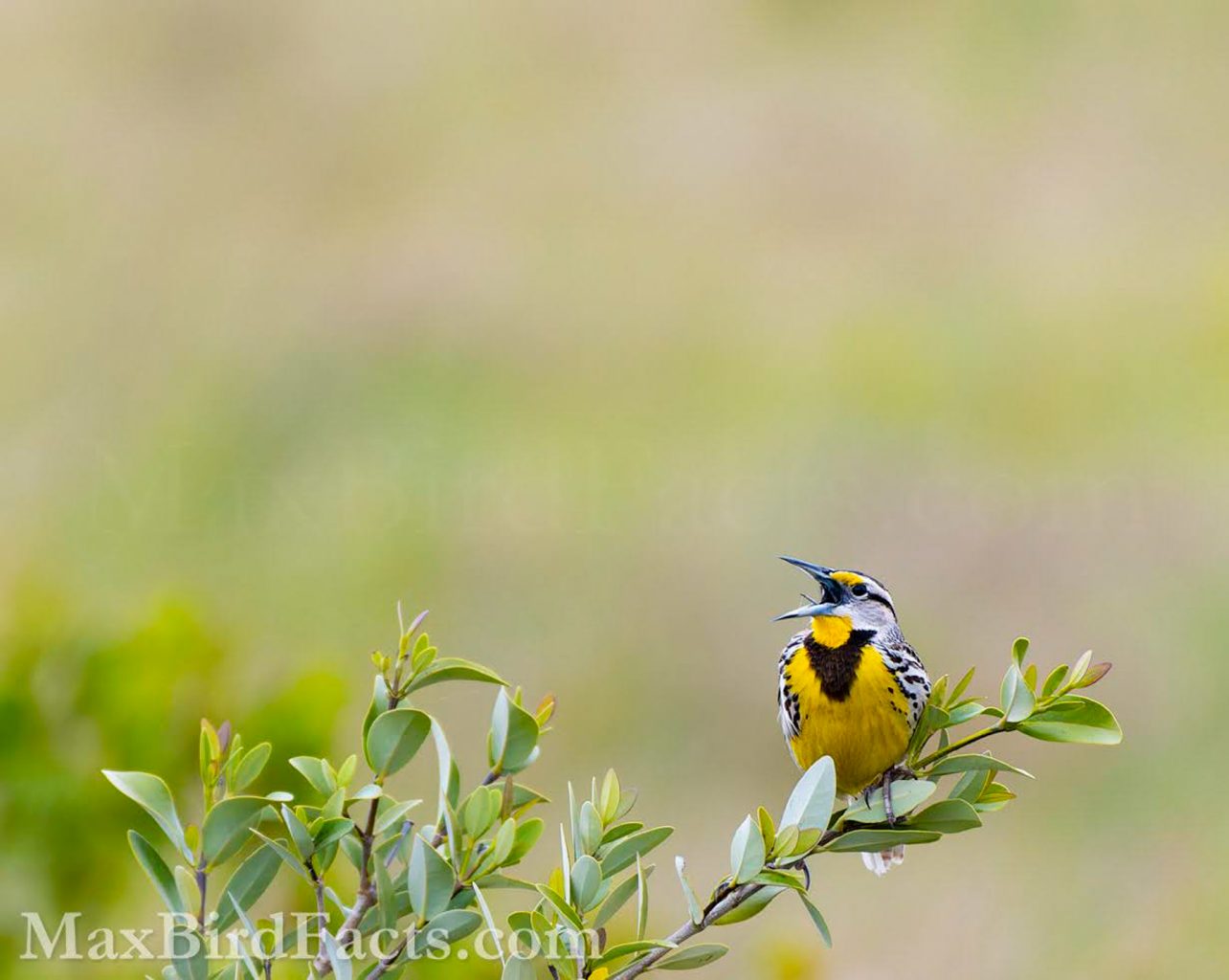
Adult male eastern meadowlark singing in the open.
The meadowlark’s wistful, fluty song is among my favorites for Florida birds. Aside from their tunes, the eastern meadowlark is a visually striking songbird. In dry grass, its drab brown, white, and black back conceals it effortlessly, but when it turns toward you, its brilliant yellow throat and belly, broken by a slash of black necklace, glimmer like gold.
Standing hunched over in the shade of the mangrove boughs, I waited until this wonderful surprise worked his way closer and closer to me. Finally, after nearly 10 minutes of abiding, the meadowlark fluttered to a mangrove on the opposite bank of the lagoon that separated us, turned to face me, and belted out a beautiful melody. After capturing the image I desired, I thanked the meadowlark and slowly backed out of my hiding place.
Not more than 30 yards down the trail, I heard another call, one I didn’t recognize. It started with a rising inflection followed by a falling one, and ended with another rising inflection that trilled. (Think of how a ball bounces faster as you close the space between the ground, it, and your hand). Other calls were coming from the small, dark bird bouncing just out of view. These were much shorter and lacked the feeling of melody—a harsh, metallic chirp with a rising inflection and sudden stop.
After I tried to peer between the branches where this bird was stubbornly dug in, it flushed and flew across the trail less than 10 feet from me. It had a black head and back, rusty orange sides, and a white belly. After a few seconds, the mystery bird perched in an opening. I finally got my first good look at an eastern towhee (Pipilo erythrophthalmus).

Adult male white-eyed eastern towhee perched.
Though he wasn’t my intended target, this towhee was my second lifer on this Big Day. Even better, I could see this bird’s distinct eye and tell it was the native Florida subspecies, P. e. alleni. Commonly called the eastern towhee (white-eyed), the iris on these Florida birds ranges from white to cream-colored compared to the red iris of their northern relatives.
Once this newest lifer departed, I finished the loop trail without even the slightest hint of a scrub-jay. I’d be lying if I said I wasn’t a little disappointed, even after those two amazing encounters, but I figured I would head to the north trail and try my luck there.
My initial thought when I first walked on the north trail was how different it was from the south loop. Its path was loose sugar sand rather than the packed dirt I had just finished walking. The vegetation was also much different. Rather than mangroves, tangled vines, and shrubs, the north trail had dense oak scrub. I kicked myself for not checking this trail sooner. I had convinced myself these jays would be on the south loop due to the overall higher bird activity, but the north trail held their preferred habitat. I slowly made my way down the path, keeping quiet so I wouldn’t startle any scrub-jays.
As I rounded the corner, I noticed some wiry grass on the trail ahead, with something hopping in it. I quickly brought my camera up as it flew into the scrub, but I managed to snap a few images before it disappeared. Pulling up the shot on my camera’s display, I saw the telltale blue head, wings, and tail separated by a soft gray back with no discernable black markings. Meaning I had finally found my Florida scrub-jays!

Adult Florida scrub-jay flying into the brush.
As excited as I was, I didn’t want this brief encounter to end our first meeting, so I stood in the shade and waited. I was quickly rewarded by hearing the iconic rasping weep call I had listened to the night before.
A few seconds later, a second call came from farther away. Its sender perched at the top of a dead branch, and the original jay joined it. I couldn’t believe my luck—two Florida scrub-jays!
I slowly started to walk toward my targets, but they spotted me and took off screaming into the brush. I backed into the shade again, and they flew over the low scrub and perched at the top of a dead tree back up the trail.
Again, I slowly approached, and this time, the birds didn’t move and only made quiet murmurs to each other. I found a good spot where I was close enough to the tree to have a good angle on the birds and enough distance that they weren’t stressed.
My positioning was perfect because shortly after settling in, the two scrub-jays started working their way back down to the oak scrub. One bird swooped to the ground, returned to its partner with something in its beak, and began eating it.

Pair of adult Florida scrub-jays perched and feeding.
The other bird watched its companion and hopped down to find its own meal. Soon it emerged from the brush holding an acorn in its jaws, a favorite meal for scrub-jays. This bird was low, roughly eye-level, and I tried to stay as still as possible. It moved around the branches, swallowed the acorn to be stashed later, and perched, looking directly at me. Watching this bird through my lens, I could almost feel it trying to figure out what I was doing in its home.
As I thought this, the scrub-jay launched off its perch and flew within inches of my head, where I felt the wind off its wings. This was a clear aggravation display, so I began to back away from where it landed, but the bird popped into a window in the oak scrub, making sure I got the message. However, in doing this, the Florida scrub-jay gave me the image I’d dreamed of the night before.
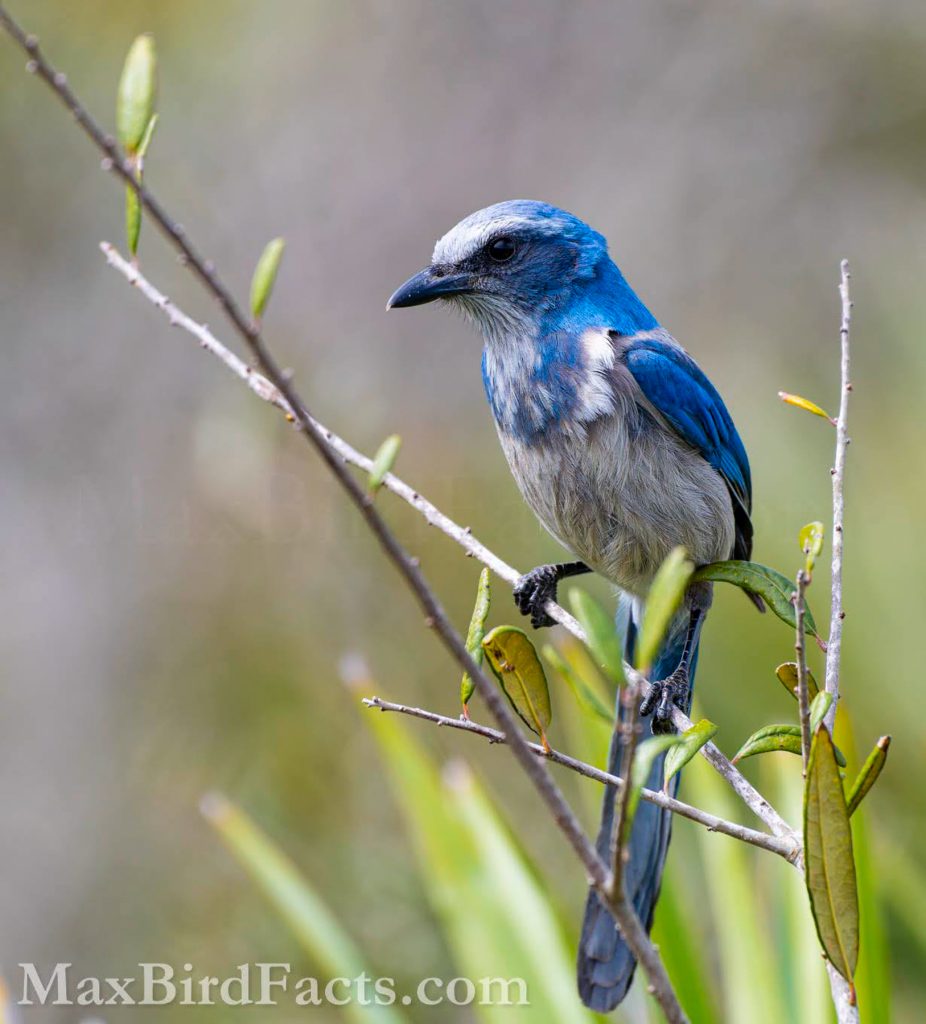
The photo I had dreamed of for months finally came into existence! This beautiful adult Florida scrub-jay posed perfectly for its portrait.
After giving me the message, I slowly walked away, not wanting to overstay my welcome. I watched as the Florida scrub-jays flew deeper into their labyrinth of branches, feeling stunned by our interaction.
Walking back to my truck, I checked the shots on my camera to ensure they were focused, and I almost jumped when I saw the detail on my target species. Then I started the short drive to Black Point to find my last target, the rare bird people on eBird had been recording.
Black Point Wildlife Drive
Pulling into the wildlife drive after paying the honor-system entrance fee, I was greeted by the usual suspects. Anhingas (Anhinga anhinga) clung to the mangroves to dry off their feathers, belted kingfishers (Megaceryle alcyon) screamed their rattling calls as they rocketed down the canal to the side of the road, and least sandpipers (Calidris minutilla) and lesser yellowlegs (Tringa flavipes) scurried and probed at the mudflats.
After a few minutes of driving, I saw a slender bird frantically running around a shallow pond with its wings outstretched. This is the humorous yet effective hunting dance of the reddish egret (Egretta rufescens).

Adult reddish egret chasing down minnows.
This seemingly odd behavior of running around is a very useful way for the bird to startle its prey and make them a more apparent target. Flashing their wings also allows the egret to corral fish into shallower water, making their capture much easier. I sat and watched this hunting dance until the bird caught its fill and leisurely strolled back to the shade of the bank.
Just a few seconds after the reddish egret finished its show, a shadow raced across the road in front of my truck. A stunning female northern harrier (Circus hudsonius) covered the span of the open sky with a few flaps of her wings and dove behind the cover of the mangroves.

Adult female northern harrier flying low over the mangroves.
Shortly after disappearing, she emerged and started her own hunting dance.
Harriers are patient predators of small mammals, and when they spot their victim, they hover perfectly still over their meal’s hiding place until it panics. When the rodent flushes, the harrier quickly dives through the brush, chases down the prey, and captures it in its talons.
As I mentioned earlier, I had searched through other people’s lists on eBird and seen a handful of listings for a cinnamon teal (Spatula cyanoptera). This species of duck typically ends its eastern range along the Gulf Coast of Texas, so it being spotted on the Atlantic Coast of Florida was a big deal.
While reading the lists, I thought they were surely mistaken for some other species until I saw someone posted a photo of a stunning male cinnamon. I knew this rare bird had to make it onto my list for my first Big Day.
Reaching the location other birders had spotted the cinnamon the day prior, I parked my truck and started walking. The trail was an old service road with a narrow canal on one side and a shallow lagoon on the other. Blue-winged teal (Spatula discors) were hanging out in the shade of the dense mangroves in the canal. Some bobbed below for a meal, but most seemed content with an afternoon nap.

A group of blue-winged teal hiding in the mangrove canal.
This more common species was a perfect indicator since the rare duck reportedly hung out with them. This behavior of staying near similarly related species is fairly common for birds that find themselves outside of their typical range.
I looked through my camera and scanned the prop roots in case my target was hiding between them. As I slowly descended the service road, I passed another birder and asked if he had spotted the cinnamon teal. He said he had, and that it was only a few yards down the trail.
With this news, I quickened my pace and stopped when I saw the area the birder described. The mangroves opened into a wider reservoir, where a fair number of blue-winged teal fed and a tricolored heron stalked minnows. Then, after looking through the native ducks, I spotted my target. The stunning male cinnamon teal was in the open, swimming among its more common cousins in the brackish water.

Adult male cinnamon teal, right, with adult male blue-winged teal, left.
Admittedly, I raised my camera too quickly and startled the ducks into the cover of the mangroves. Thankfully, I was the only one there, so I didn’t ruin anyone else’s view of this rare duck.
With the cinnamon hiding, I sat on the path and waited for it to emerge. I knew it would only be a matter of time before it had to come out and feed. My patience was rewarded.
Shortly after emerging from the mangroves, the cinnamon teal decided to preen its feathers. Birds do this by combing them with their beaks, washing them in a bird bath, or taking a dust bath. However, duck preening is always a show.
The way this duck bathed was spectacular. It first lowered its head under the water, then raised it and rubbed the water onto its wings. After repeating this twice for both wings, it stretched out its neck and shook its whole body like a wet dog. It then took a few more dips to coat its feathers with water, and the oils in its feathers caused the water to simply slip off it in sheets.
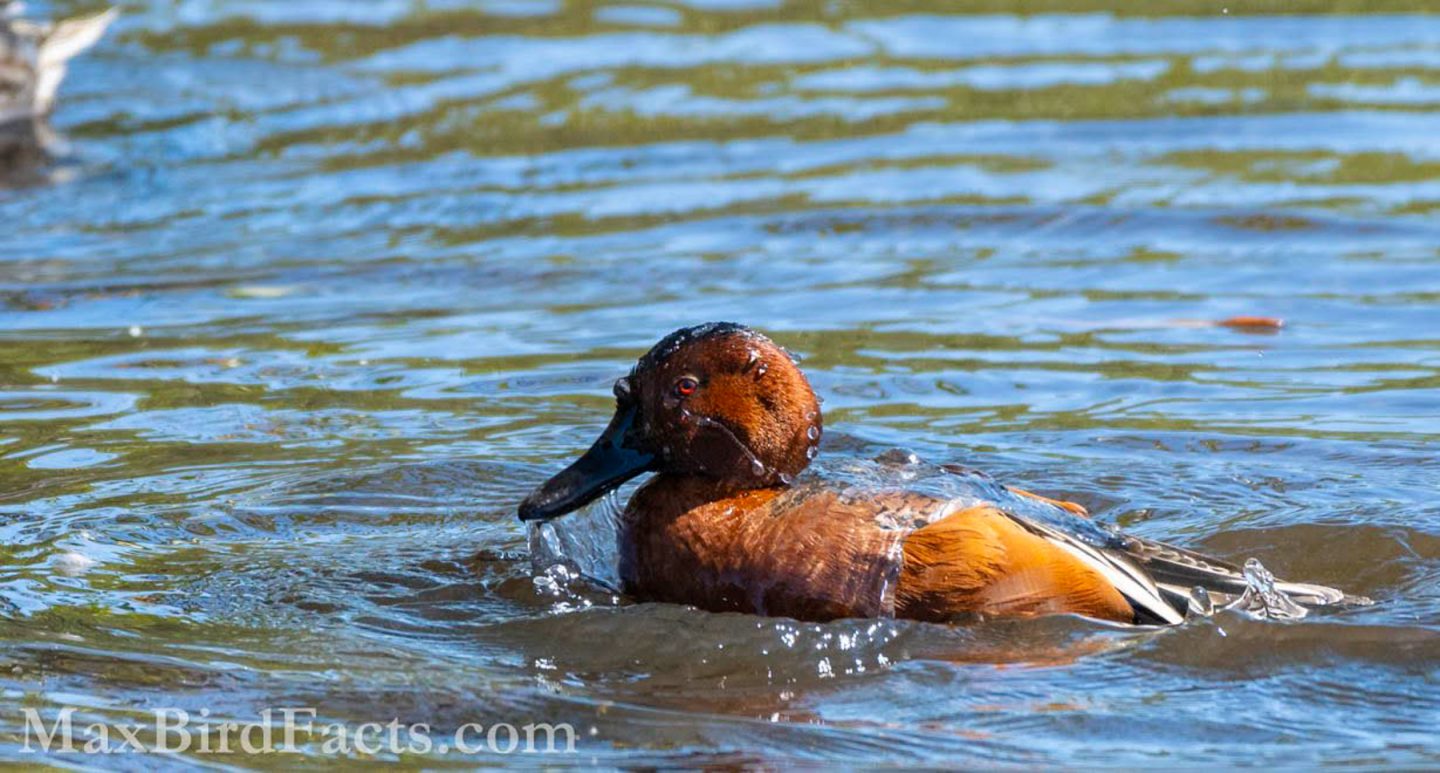
Adult male cinnamon teal bathing.
After sitting and watching the cinnamon teal for a while, I slowly stood up and walked away. I recorded my sighting in the eBird app and wrote a short description for the rare bird alert.
Back in my truck, I couldn’t be happier. According to my field guides, I’d found a species that shouldn’t be anywhere near Florida. I stopped a few more times to look for other species to bulk up my list, but I couldn’t stop smiling at my triumph.
Celebrating Success
As I drove off the island, the high of finally finding the Florida scrub-jays and cinnamon teal slowly faded. I decided to stop to reflect on my day’s accomplishments. Just outside the island, I pulled over and parked facing the Indian River. I grabbed the trail mix and my camera (in case of any potential shorebirds), walked down the beach, and sat in the shade of a squat palm tree.
In a little under six hours of birding, I had recorded a total of 50 species, four of which were lifers. Not only had I earned these four new species, but I had also gotten some great images of them. Even some of the sightings of more common birds, like the common grackle at the Orlando Wetlands or the eastern meadowlark at Scrub Ridge, were stunning encounters that resulted in images that are still some of my favorites.

Adult male common grackle from the Orlando Wetlands Park.
I scanned the water’s surface for gulls or skimmers flying or bobbing in the waves and ate a handful of trail mix. I didn’t see any, so I leaned back in the sand and listened to the tide lapping against the shore. After resting in the shade and enjoying the salty breeze for a while, I got up and drove home, eager for my next opportunity for birding.
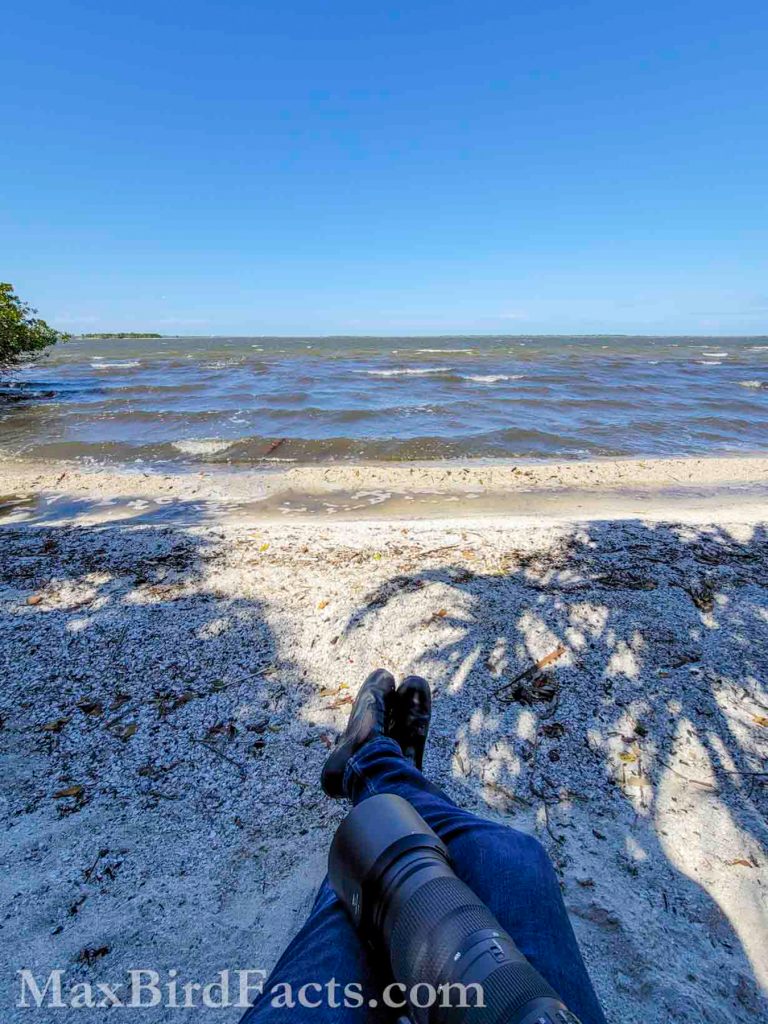
My view while reflecting on the sightings of the day.
Max Weakley lives in Florida, where he graduated from the University of Central Florida in 2019 with a degree in biology. In his senior year, he took an ornithology class that opened his eyes to the fascinating world of birds. He started an Audubon campus chapter at UCF, where he has returned to talk about wildlife photography and life after graduation. He also has led photography and birding-centered walks in his state. Visit his website, MaxBirdFacts, to explore more.

